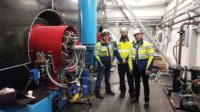The electric power sector leads the way in the program with 105 reporters. These include nearly all of the largest generating utilities in the United States, encompassing such projects as improved plant efficiencies, cogeneration, use of non-fossil fuels, and demand-side management programs that reduce power use by their customers.
The number of participants from outside the electric power industry was more than six times the number reporting in the first year of the program, and includes such industries as automobile manufacturing, petroleum production and refining, coal mining, the chemical industry, the metals industry, and health care to name a few.
The Voluntary Reporting of Greenhouse Gases Program was developed to find innovative, low-cost, and nonregulatory approaches to limit emissions of greenhouse gases, such as carbon dioxide, methane, nitrous oxide, and halogenated substances. The program is a way for a company or organization to establish a public record of its achievements in reducing or offsetting emissions.



